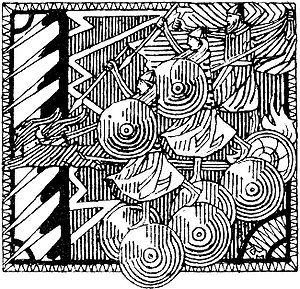Battle of Hjörungavágr
| Battle of Hjörungavágr | |||||||
|---|---|---|---|---|---|---|---|
 The hailstorm during the Battle of Hjörungavágr, by Halfdan Egedius | |||||||
| |||||||
| Belligerents | |||||||
| Norway | Jomsvikings | ||||||
| Commanders and leaders | |||||||
|
Haakon Sigurdsson Eric Haakonsson Sweyn Haakonsson |
Sigvaldi Strut-Haraldsson Vagn Åkesson Búi digri | ||||||
| Strength | |||||||
| 180 ships | 60 ships | ||||||
The Battle of Hjörungavágr (Norwegian: Slaget ved Hjørungavåg) is a semi-legendary naval battle that took place in the late 10th century between the Jarls of Lade and a Danish invasion fleet led by the fabled Jomsvikings. This battle played an important role in the struggle by Haakon Sigurdsson (c. 937 – 995) to unite his rule over Norway. Traditionally, the battle has been set during the year 986. [1] [2]
History
During this period, Denmark was the dominant power in the Nordic region. Southern Norway and the Oslo Fjord sometimes lay directly under Danish rule. Haakon Sigurdsson ruled Norway as a vassal of King Harald Bluetooth of Denmark (died c. 985/86). In reality but he was an independent ruler. Haakon was a strong believer in the old Norse gods. When Harald Bluetooth attempted to force Christianity upon him around 975, Haakon broke his allegiance to Denmark. Harald Bluetooth had suffered defeat from Otto II, Holy Roman Emperor during 974. Haakon took advantage of the weakened position of the Danish king to make Norway independent of Denmark. With the convincing victory, Haakon Sigurdsson remained Norway's sole ruler and Denmark's claim over Norway was rejected and not repeated until many years later. [3] [4]


Location
Jómsvíkinga saga offers two mutually contradictory descriptions of the bay on the coast of Sunnmøre in which the battle took place. According to the first one, Hjorungavágr lies on the landward side of the island Hoð (now Hareidlandet in Møre og Romsdal). According to the other, the bay is situated south of an island called Primsigð/Primsignd and north of an island called Horund. Both of these names are not in common use today.[5] [6] [7] [8]
Sources
The battle is described in the Norse kings' sagas—including Heimskringla—as well as in Jómsvíkinga saga and Saxo Grammaticus' Gesta Danorum. Saxo Grammaticus estimated that the battle took place while Harald Bluetooth was still alive. Tradition has set the battle in 986. Some contemporary skaldic poetry alludes to the battle, including verses by Þórðr Kolbeinsson and Tindr Hallkelsson. The battle was also the subject of later poems and sagas. Jómsvíkingadrápa by Bjarni Kolbeinsson honors the fallen Jomsvikings at the Battle of Hjörungavágr. Vellekla, composed by the Icelandic skald Einarr Helgason, speaks of the Battle of Hjörungavágr. Fagrskinna, contains a history of Norway with a heavy emphasis on battles, including the Battle of Hjörungavágr.
See also
- Sigvaldi Strut-Haraldsson
- Vagn Åkesson
- Eiríkr Hákonarson
- Thorkell the Tall
- Vigfúss Víga-Glúmsson
- Þorgerðr Hölgabrúðr and Irpa
References
- ^ "Slaget ved Hjørungavåg". University of Oslo. Retrieved June 1, 2018.
- ^ Jørn Sandnes. "Håkon Sigurdsson". Norsk biografisk leksikon. Retrieved June 1, 2018.
- ^ "Harald Bluetooth". danmarkskonger.dk. Retrieved June 1, 2018.
- ^ "Slaget ved Hjørungavåg". Allkunne. Retrieved June 1, 2018.
- ^ John Megaard, "Hvor sto 'Slaget i Hjörungavágr'?: Jomsvikingeberetningens stedsnavn og Sæmundr fróði" Alvíssmál 9 (1999): 29–54 (English summary, p. 54) Archived April 8, 2016, at the Wayback Machine
- ^ Johan Ottesen (December 3, 2010). "Her er slagstaden". Sunnmøresposten. Retrieved June 1, 2018.
- ^ "Kvar var Hjørungavåg?". NRK. Retrieved June 1, 2018.
- ^ Geir Thorsnæs. "Hareidlandet". Store norske leksikon. Retrieved June 1, 2018.
Related reading
- Näsström, Britt-Mari (2001) Blot - tro og offer i det førkristne Norden (Pax) ISBN 82-530-2146-1
- Steinsland, Gro (2005) Norrøn religion. Myter, riter, samfunn (Pax) ISBN 82-530-2607-2
- Fløtre, Odd Karstein (2009) Jomsvikingslaget i oppklarende lys (Hatlehols Grafiske AS) ISBN 978-82-92055-34-2
- Ottesen, Johan (2010) Slagstaden (Fotoarkivet) ISBN 978-82-93042-01-3
- Larsen, Stein Ugelvik (2006) Striden om stedet : Hjørungavåg-slaget i norsk historie og kulturdebatt (Sunnmørsposten forl.) ISBN 82-914-5014-5
